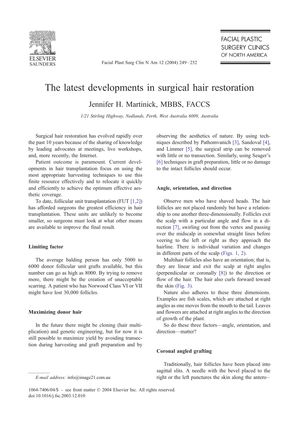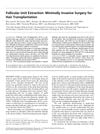The latest developments in surgical hair restoration
May 2004
in “Facial Plastic Surgery Clinics of North America”

TLDR By 2004, Follicular Unit Transplantation (FUT) was the most effective method for surgical hair restoration, while the newer Follicular Unit Extraction (FUE) had more disadvantages and was less recommended.
In 2004, surgical hair restoration had advanced significantly, focusing on effective harvesting techniques for optimal aesthetic coverage. The most efficient method was Follicular Unit Transplantation (FUT), with an average balding person having 5000 to 6000 donor follicular unit grafts available, and a maximum of 8000. Techniques were developed to maximize yield and avoid transection during harvesting and graft preparation. The orientation and direction of hair follicles were also considered crucial for a natural look. Follicular Unit Extraction (FUE), a newer technique, avoided creating a linear scar but had disadvantages like a higher likelihood of transection, reduced survival of grafted hair, and longer procedure time. The author suggested that FUE might have a minor role in hair restoration, but avoiding its use seemed more sensible.
View this study on linkinghub.elsevier.com →
Cited in this study

research Follicular Unit Extraction: Minimally Invasive Surgery for Hair Transplantation
Follicular Unit Extraction (FUE) is a less invasive hair transplant method with minimal scarring, suitable for about 60% of patients, especially those needing fewer grafts and quicker recovery.